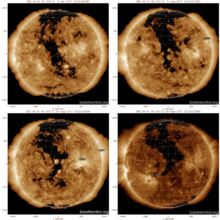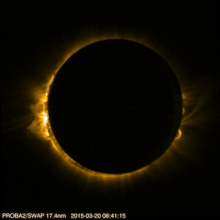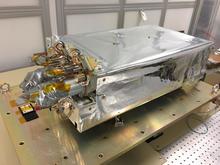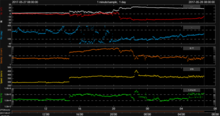press
Submitted on 2019-10-18
Brussels, 18 October 2019 – Ever closer to the Sun! The instrument EUI (Extreme Ultraviolet Imager) is integrated into the Solar Orbiter satellite to be launched towards the Sun in February 2020. Today, Solar Orbiter can be seen for the last time before being shipped to Cape Canaveral, the launch site.
Submitted on 2017-11-24
The European Space Weather Week (ESWW) is one of the main international conferences when it comes to space weather. Already for the 12th time, its organisation is in the hands of the STCE.
Submitted on 2017-09-28
Earth is currently (28 September) under the influence of a high speed stream from a coronal hole. A strong geomagnetic storm is in progress. Polar lights will not be visible from Belgium.
Submitted on 2017-08-11
The Monday August 21 eclipse will transit the whole of North America. If you can't make it to there, no problem. We have a reporter, live from space: our satellite PROBA2.
Submitted on 2017-06-02
This is it: the solar telescope EUI is ready to be mounted on the Solar Orbiter satellite. Solar Orbiter will be launched in 2019 and will approach the Sun closer than any other satellite ever. (NL-FR-EN)
Submitted on 2017-05-28
A partial halo CME from 23 May resulted in a strong geomagnetic storm on 28 May.
Submitted on 2016-05-04On Monday 9 May, between 13:12:19 and 20:40:33 local time, a Mercury transit across the solar disk will be visible in its entirety from Belgium. This event will not be visible with the naked eye. A (small) telescope will be required.
Submitted on 2016-05-04Op maandag 9 mei, van 13:12:19 tot 20:40:33 lokale tijd, vindt een Mercuriusovergang plaats die zichtbaar is vanuit heel België. De transit zal niet zichtbaar zijn met het blote oog. Een (kleine) telescoop is nodig.
Submitted on 2016-05-04Le lundi 9 mai, de 13h12m19s à 20h40m33s (heure locale) nous pourrons voir depuis la Belgique entière Mercure passer devant le Soleil, événement qui s'appelle transit de Mercure. Cet événement ne sera pas visible à l'oeil nu, un (petit) téléscope sera nécessaire.
Pages
Zircon - This is a contributing Drupal Theme
Design by
WeebPal.
























